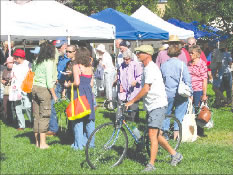(Tips for high-altitude gardeners)
by Suzanne Ward
At long last it is June, the last frost date and time to plant the garden.? Keep an eye on the weather at this time of year, as it can change quickly.? My farmer father always said, “If you don’t like the weather in Colorado, just wait ten minutes.”?
?By now, you have transplanted your seedlings to larger pots and they have thrived with the larger root space.? Now it’s time to harden them off outside.? The delicate plants cannot be dropped into outside soil without letting them have time to get used to the elements.?
?Hardening-off protects your plants from sudden changes in temperature.? Take your potted plants outside for an hour.? Keep them out of full sunlight at first and out of the wind, gradually?increasing the time outside, adding an hour each day.? At the end of about two weeks, they can be left out for a full day in the sunlight.? Time this so at the end of two weeks you can put them into the soil in your garden.
?If you have a cold frame this process is made much easier.? Put the plants in the cold frame, covered, for the first few days.? Later, open the cover just a bit and continue this process a bit more each day, until the end of the two weeks, at which time you can remove the top.
?There are many products available to help extend the growing season.? One such product, especially for warm weather crops such as tomatoes, is the “wall of water.”? This is a plastic tepee with tubes, which is filled with water to create a greenhouse effect.? This allows you to put out tomatoes earlier and thus harvest sooner in our cooler climate.? When the tomatoes have grown to fill the space, remove the walls.
?Some folks make hoop houses in their gardens.? These hoop houses are placed in the garden bed and are used to protect plants in the early spring and again in the fall, thus extending the growing season.? Tunnel covers are also available.? These can be found in seed catalogues or at your local nursery.?
?While the plants are hardening off, prepare the soil.
?There are many methods of soil preparation depending upon the type of garden you are planting.? If planting in a formerly used garden space, simply spread aged compost or manure one inch deep and till to a depth of about eight inches with a garden spade.? Spading works just fine and prevents damage to the soil organisms.? If you have a very large area, consider a rototiller.? Rake the area very well, leaving a smooth, loose soil bed for your plants.
?Keep in mind the needs of cold weather and warm weather plants.? The cool weather cabbages, broccoli and cauliflower can be put in a few weeks before the last frost date.? The warm weather plants – tomatoes, cucumbers and peppers – should wait until the soil is warmed, usually two weeks after the last frost date.? Seed packages tell you when to plant as well as the depth and spacing of the plants.
?Plant your seedlings in the evening or on an overcast day, not in the direct hot sun, as they will wither.? Seed planting, however, is recommended during the day in warmed soil.? Tamp the seeds down into the soil with the back of a rake.? This eliminates air space around the seeds.
?At first the seedlings will require frequent watering. Also the seeds need to be kept moist so they will germinate, but not too wet, or they will rot.? Watering is the topic of next month’s article.
?There are many resources for learning about gardening.? Research can be done on the Internet, in the library or by asking local gardeners.? One of the best resources I have found is a man I know who raises a beautiful garden.? We talk over the fence and he gives me advice.? This is the best kind of community building.
?
Suzanne Ward lives in Salida.? When she is not gardening she is involved in sustainability projects.

